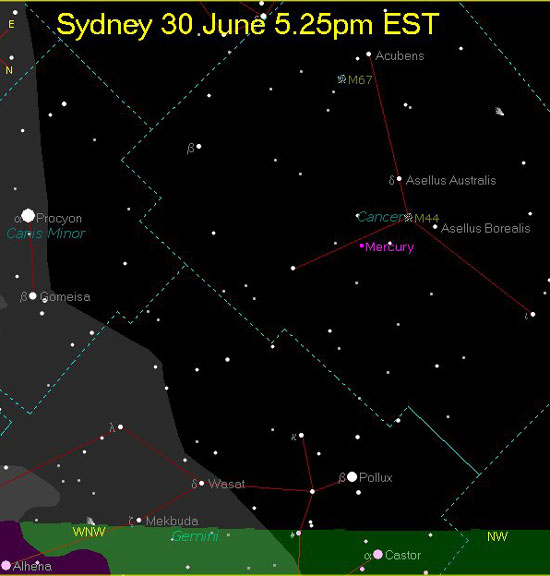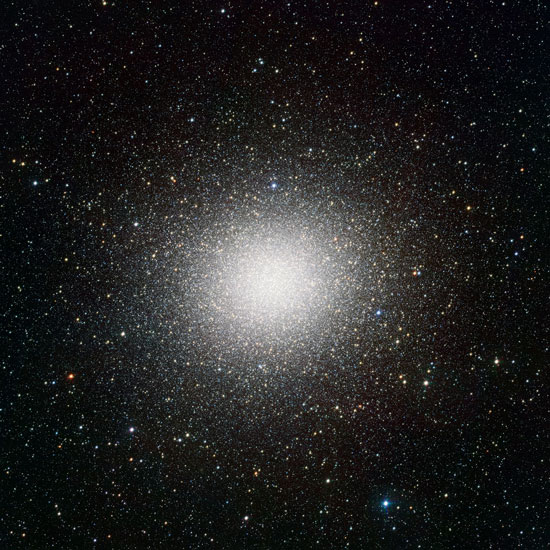

June 2012

All the major planets are on show in June with Venus and Jupiter improving morning objects, Mars and Saturn fading evening objects and tiny Mercury putting on a little evening cameo.

Mercury is well placed in the evening sky at the end of June. Graphic made using the Sky version 5 www.bisque.com
Mercury pops up in the evening sky after last month's superior conjunction on its way to greatest eastern elongation on 1 July. Although this is not the best apparition for the Southern Hemisphere, it will be well worth trying to track down the innermost planet as it attains a respectable altitude of 16 degrees by the end of June at the beginning of nautical twilight. Start looking for Mercury at the start of the second week in June; on the evening of 11 June from Sydney it will be in the north-western sky almost six degrees up at 5.20pm EST (30 minutes after sunset), shining at magnitude -0.7 and sporting a gibbous 78 percent illuminated phase across its 5.7 arcsecond disc. As the month progresses it steadily pulls away from the sunset horizon, fading all the time as its phase decreases and disc swells. On 30 June at 5.25pm it can be found a healthy 16 degrees up among the stars of Cancer, three degrees west of the brilliant Beehive open cluster (M44). Through a telescope Mercury shows its crescent phase, illuminated by 42 percent across a disc spanning eight arcseconds. Mercury will remain in the morning sky well into July giving observers apply opportunity to glimpse this fascinating, elusive body.

Venus and Jupiter make for a splendid sight in the morning sky close to the Hyades and Pleiades star clusters at the end of June. Graphic made using the Sky version 5 www.bisque.com
Venus rapidly reappears in the morning sky following its momentous solar transit and then make fast progress pulling away from the sunrise horizon. On 15 June at around 6.30am EST (30 minutes before sunrise) it is a blazing mag. -4.1 beacon about six degrees up in the east-north-east sky, close to the Hyades and Aldebaran (alpha Tau). Five days later it has moved among the Hyades, brightened to mag. -4.24 and is about 12 degrees up. At the month's end it is brightened to mag. -4.43, is a healthy 20 degrees up and a small telescope will easily show its thin crescent spanning 45 arcseconds. The gas giant Jupiter is just above Venus and although bright in its own right at mag. -2.1, it is completely overshadowed by Venus brilliance. Binoculars will show the four Galilean satellites and small telescopes will show some of their eclipse and occultation phenomena.
Mars is still well placed for evening observing among the stars of Leo at the start of the month. It sets at midnight but not until giving up a healthy four hour observing window. Although it has faded to mag. +0.5 and shrunk to 7.8 arcseconds in apparent diameter, experienced visual observers and imagers can still tease some surface detail out. The red planet moves into Virgo by the end of June, by which time it has faded to mag. +0.85 and slimed down to 6.6 arcseconds.
The beautiful ringed planet Saturn is close to Spica in Virgo all month and it will be interesting to compare their magnitudes and colour; Saturn at mag. +0.6 is about four tenths of a mag. brighter and has a noticeably yellow hue whereas Spica is white. It is observable to about 1am at the start of June, setting just after 3am. There is still a lot of time to enjoy Saturn's beauty as June draws to a close, as the ringed planet doesn't set until just after 1am EST from Sydney. Look out for Saturn's largest Moon Titan, at mag. +8 just visible in 10x50 binoculars. Both of the ice giants Uranus and Neptune are well placed by 2am at the end of June, lying in the constellations of Cetus and Aquarius respectively. If you have dark skies then Uranus can be glimpsed with the naked eye but Neptune requires binoculars.
Moving into the depths of deep space, the teapot in Sagittarius is clear of the east-south-east horizon by 7pm EST mid June, when the skies are astronomically dark. Scorpius' sting is just above with the magnificent open clusters M6 and M7 ripe for observation. High up in the south is magnificent Crux, the Southern Cross and brilliant Centaurus. June nights present so many bright deep-sky objects to observe over the course of the long winters night that it's difficult to know where to start. For beginners to observational astronomy it's a good idea to stick to the brightest quarry and a good choice would be to observe globular clusters, the blazing balls of tightly packed stars.
The biggest and brightest example in the entire sky lies in Centaurus and it is so bright that it has received a Bayer designation, namely Omega Centauri. Omega shines at magnitude +3.5 and it is clearly non-stellar to the naked eye as it is a huge beast, spanning almost a degree of sky. Large, mounted binoculars will give spectacular views and hint at resolution of the outlying regions, but truly breathtaking views are to be had through a telescope. Omega is ten times as massive as run-of-the-mill globulars, weighing in at five million solar masses and is thought to contain ten million stars. It is also the fastest rotating globular, which gives it a distinctly oblate rather than spherical shape. There is strong evidence that Omega is the core of an ancient satellite galaxy that was ripped apart by tidal forces after an encounter(s) with our Galaxy. This is the best time to observe its magnificence as it culminates almost overhead.

The globular cluster, Omega Centauri. Image: ESO.
After observing Omega any other globular may seem tame but M22 (NGC6656) in Sagittarius is a great globular by any standards and ranked the third best in the entire sky. By 10pm M22 is 50 degrees up, high enough to secure the views that do it justice. It shines at mag. +5.1 and images show it extends to 33 arcminutes in size. Even 'scopes as small as 60-mm start to resolve individual stars. M22 lies relatively close to us at 10,400 light years compared to 15,000 light years for Omega Centauri. Despite its glorious appearance it is really an average cluster of half a million solar masses in a sphere 100 light years across.
Those with the stamina to wait up until after midnight will be rewarded with views of the second best globular cluster, 47 Tucanae (NGC 104). It blazes away at mag. +4 and due to its huge 50 arcminute apparent diameter it has the appearance to the naked eye of a fuzzy star. It is more compact than Omega and M22 and binoculars will hint at a bright core. If you can get your hands on a 100-mm 'scope then some of the one million stars crammed into this giant ball of light some 120 light years across can start to be individually seen.
|



